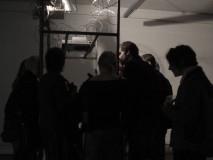The Leak
The term LEAK describes an area within the architecture at which there is a kind of permeability. As mentioned above the bulky design of prisons serves to isolate the individual. The criminal’s body is limited and fixed to the space of his cell. He may be able to use the yard or to get access to the workspaces but still all his actions are limited to the confines of the carceral. In his book “Discipline and Punish“ Foucault describes the segmentation of the prison complex into three models, to which he assigns different spaces with specific rehabilitative capacities. The three models are the cell, the workshop and the hospital. Depending on his level of improvement, the detainee can gain access to these spaces, although his movement within these spaces is strictly scheduled. The prisoners mind cannot be limited to the spaces that hold the body. In the isolation of his cell the detainee is left alone with his thoughts, whereas the physical exhaustion in the workplace lets his mind come to rest. The loneliness of the cell, the isolation in a confined, sterile room represents the least desirable condition. By using their mobiles from within the cell, the detainees can break out of these austere conditions. The moment of self reflection is broken as the temporal axis of their thoughts is transported back from the past to the now. From the loneliness of their imprisonment they may now make contact with the outside world and reconnect to their parallel lives outside the prison walls. The architecture of confinement is overcome as the electronic prosthesis creates a leak through the prison’s static walls.
This leak is at the same time cultural and technical in nature. On one hand it encompasses the frequencies of different sources relevant for communication as for example TV, radio, WLAN or said mobiles. On the other hand, from the cultural point of view, it also encompasses the contents transported via the broadband frequencies. The cultural leak is extended by the individual biographies and certain aspects of prison culture, which subsequently seeps into world outside and takes roots.
Villém Flusser describes a leak regarding architecture in his book “Medienkultur” : „Das heile Haus wurde zur Ruine, durch deren Risse der Wind der Kommunikation bläst.“* Flusser’s terminology of public and private space cannot be readily transferred to prison, as it symbolizes a political space with its own set of rules. With regards to architecture, Flusser’s scenario is sound: the cracks he describes can be attributed to the Leak. The mobile phones that the prisoners in the IPPS use create cracks in the architecture of power. The inside seeps into the outside and vice versa.
*„The house that was whole became a ruin, through its cracks the wind of communication blows. “
Villem Flusser, Medienkultur


